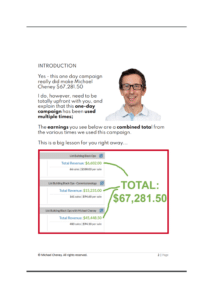Crafting Compelling Lead Magnets: A comprehensive guide on creating effective lead magnets to capture and nurture potential customers, including strategies for crafting, designing, promoting, refining, and aligning lead magnets with products or services for conversion, as well as addressing common challenges and exploring the future of lead magnets in marketing.

Introduction to Crafting Compelling Lead Magnets
Lead magnets are indispensable tools for businesses aiming to capture leads by offering valuable resources or incentives in exchange for contact information. These lead magnets serve as the initial point of contact with potential customers, kickstarting the process of building relationships that can lead to conversions. Understanding the audience’s pain points, desires, and preferences is paramount in crafting lead magnets that resonate effectively and add significant value. For instance, a fashion brand could create a lead magnet in the form of an exclusive style guide tailored to the latest trends, providing fashion enthusiasts with valuable insights and establishing the brand as an authority in the fashion industry.
The primary goal of lead magnets is not only to capture leads but also to nurture them towards conversion, making them an essential component of any marketing strategy. By offering something of value to the audience in exchange for contact details, lead magnets provide businesses with insights into customer preferences and pain points that can inform targeted marketing efforts. For example, a software company offering a free trial of its product as a lead magnet can learn about user preferences and behaviours, enabling them to tailor future offerings to meet customer needs more effectively.
Moreover, lead magnets play a pivotal role in enhancing customer engagement and brand loyalty. Businesses that incorporate lead magnets into their marketing strategy often experience increased interaction with their target audience, leading to stronger relationships and brand advocacy. For instance, a wellness brand providing a free recipe ebook as a lead magnet not only captures leads interested in healthy living but also fosters a sense of community and trust among its audience. The use of lead magnets is not limited to specific industries; rather, they are versatile tools that can be customised to meet the unique needs of different businesses and audiences.
 Importance of Lead Magnets in Lead Generation
Importance of Lead Magnets in Lead Generation
Lead magnets are not just about capturing leads; they are also valuable tools for gathering insights that can inform marketing strategies and drive business growth. By offering something of value to the audience, businesses can gain a deeper understanding of customer preferences, pain points, and motivations, which can be used to tailor products and services effectively. For example, an educational institution offering a free webinar on career development can gather insights into the aspirations and challenges of its target audience, enabling them to create relevant courses and programmes.
The impact of well-crafted lead magnets extends beyond lead generation, contributing significantly to higher conversion rates and improved customer engagement. When businesses create lead magnets that address specific needs or provide solutions to common problems, they increase the chances of converting leads into customers. For instance, a travel agency offering a free destination guide as a lead magnet can attract travel enthusiasts looking for vacation ideas and inspire them to book trips through the agency. The ability of lead magnets to guide potential customers through the sales funnel and nurture them towards conversion underscores their importance in driving business growth and revenue.
Furthermore, businesses that use lead magnets in their marketing strategy often experience enhanced brand loyalty and customer retention. By consistently providing valuable resources and building trust with their audience through lead magnets, companies can establish long-lasting relationships that go beyond one-time transactions. For example, a beauty brand offering a free skincare consultation as a lead magnet not only captures leads interested in skincare but also positions the brand as a trusted advisor in the beauty industry. The loyalty and advocacy generated through effective lead magnets can have a lasting impact on customer retention and brand reputation.
 Different Types of Lead Magnets
Different Types of Lead Magnets
Lead magnets come in a diverse range of formats, each serving a specific purpose in attracting and engaging potential leads. For instance, while ebooks and guides excel at providing comprehensive information and insights on a particular topic, webinars offer a live and interactive platform for businesses to showcase their expertise and engage with their audience in real-time. An example of a successful lead magnet in the form of a template could be a marketing agency providing a free social media content calendar, helping businesses streamline their social media planning and execution.
Interactive lead magnets, such as quizzes and surveys, have gained popularity for their ability to capture user attention and provide personalised experiences. By incorporating elements of gamification and interactivity, these lead magnets not only entertain the audience but also collect valuable data that can be used to tailor future marketing strategies. For instance, a finance company could create a financial health quiz to help users assess their financial habits and offer personalised advice on money management, enhancing user engagement and driving conversions. Tailoring the type of lead magnet to align with the specific preferences and needs of the target audience is essential for maximising its effectiveness in capturing leads and nurturing relationships.
Moreover, exclusive reports and industry insights serve as valuable lead magnets that provide audiences with in-depth knowledge and trends in a particular field. By offering data-driven reports and analyses, businesses can position themselves as thought leaders and valuable resources for their target audience, attracting leads interested in staying informed and up-to-date with industry developments. For example, a tech company offering a free industry report on emerging technologies can capture the attention of tech enthusiasts and professionals seeking insights into the latest trends and innovations, establishing the company as a trusted source of information within the tech community.
Strategies for Crafting Effective Lead Magnets
Crafting effective lead magnets requires a strategic approach that goes beyond just offering something for free; it involves understanding the audience’s needs and preferences to create offerings that resonate and add significant value. For instance, a lifestyle brand looking to attract new customers could conduct research to identify the lifestyle challenges and aspirations of its target audience and create a lead magnet that addresses these specific pain points. By tailoring the lead magnet content to provide solutions and inspiration, the brand can capture leads who are genuinely interested in its products and services.
Storytelling can be a powerful tool for crafting compelling lead magnets that resonate with the audience on an emotional level. For example, a charity organisation seeking to raise awareness and attract donors could create a lead magnet that shares personal stories of individuals impacted by their cause. By evoking empathy and connection through storytelling, the lead magnet becomes more than just a resource; it becomes a vehicle for inspiring action and generating support for the charity’s mission. Additionally, A/B testing different versions of lead magnets allows businesses to gather insights into what resonates best with their audience and refine their strategies for optimal performance. By experimenting with different formats, messaging, and design elements, businesses can identify the most effective approach to capture leads and drive conversions successfully.
Data-driven insights and research play a crucial role in crafting lead magnets that are not only attractive to the audience but also aligned with their needs and preferences. For instance, a market research firm looking to generate leads could create a lead magnet in the form of an industry trends report, providing businesses with valuable insights and analysis to make informed decisions. By leveraging data and research to create valuable resources, businesses can position themselves as trusted advisors and thought leaders in their industry, attracting leads seeking expert guidance and information.
Design and Presentation Best Practices
Incorporating visually appealing graphics, colours, and layouts is essential to capturing the audience’s attention and enhancing the overall user experience of lead magnets. For example, an interior design company creating a lead magnet in the form of a room makeover guide could use high-quality images and engaging visuals to showcase before-and-after transformations, inspiring users to download the guide. A visually appealing lead magnet not only attracts attention but also communicates professionalism and quality, instilling confidence in the audience about the brand and its offerings.
Implementing clear and concise messaging in lead magnets is crucial for improving comprehension and encouraging action from the audience. By delivering the message in a straightforward and compelling manner, businesses can ensure that the value proposition is effectively communicated and resonates with the target audience. For instance, a software company offering a free trial as a lead magnet could use concise and engaging copy to highlight the key features and benefits of the product, prompting users to sign up and experience its value firsthand. Clarity and conciseness in messaging not only make the lead magnet more appealing but also increase the likelihood of conversion and engagement with the brand.
Mobile responsiveness is a critical factor in lead magnet design to ensure accessibility and usability across various devices. With the increasing use of smartphones and tablets, businesses must ensure that their lead magnets are optimised for mobile viewing to provide a seamless user experience. For example, an online retailer offering a mobile-exclusive discount code as a lead magnet must ensure that the redemption process is smooth and user-friendly on mobile devices to maximise conversions. By prioritising mobile responsiveness in lead magnet design, businesses can reach a wider audience and enhance engagement with their offerings.
Promotional Strategies for Lead Magnets
Leveraging social media platforms and email marketing campaigns is an effective strategy to promote lead magnets and reach a wider audience. By creating engaging posts and targeted ads on platforms like Facebook, Instagram, and LinkedIn, businesses can attract the attention of potential leads and drive them towards the valuable resources offered in exchange for their contact information. For instance, a food delivery service promoting a free recipe ebook on social media can use mouth-watering images and compelling captions to entice food enthusiasts to download the ebook and explore new recipes.
Collaborating with influencers or industry experts can enhance the credibility and reach of lead magnets, increasing their impact and effectiveness. For example, a fitness brand partnering with a well-known fitness influencer to endorse a workout guide can leverage the influencer’s authority and reach to attract a larger audience interested in fitness tips and routines. By associating the lead magnet with reputable figures in the industry, businesses can build trust with potential leads and position themselves as valuable resources in their respective fields.
Providing sneak peeks or teaser content on the lead magnet can create intrigue and drive interest among potential leads, encouraging them to learn more and engage with the full resource. For instance, a beauty brand offering a free skincare sample as a lead magnet could tease the benefits and results of the product through social media posts and email campaigns, prompting users to sign up to receive the full-sized product. By offering a glimpse of the value and benefits of the lead magnet, businesses can generate curiosity and anticipation, increasing the likelihood of conversion and engagement with the brand.
Refining Lead Magnets through Audience Feedback
Collecting feedback from users who have interacted with lead magnets is a valuable practice that can provide insights for improvement and optimisation. By listening to the audience’s feedback, businesses can identify areas of strength and areas for enhancement, enabling them to refine the lead magnet content and user experience. For example, an online course provider offering a free trial as a lead magnet could gather feedback from trial users to understand their learning preferences and challenges, allowing the company to tailor its courses to better meet user needs.
Incorporating feedback loops into the lead magnet strategy enables businesses to iteratively enhance the value proposition and user experience based on real-time data and insights. By actively seeking and implementing user feedback, companies can demonstrate a commitment to continuous improvement and customer satisfaction, fostering loyalty and engagement with the brand. For instance, a financial consultancy using a feedback loop to gather client input on a financial planning guide can refine the content and recommendations to better address client needs and goals, enhancing the guide’s effectiveness and relevance.
Monitoring key engagement metrics, such as click-through rates and conversion rates, is essential in assessing the performance of lead magnets and making data-driven adjustments to improve results. By analysing these metrics, businesses can gain valuable insights into the effectiveness of their lead magnet strategy and identify areas for enhancement. For example, an e-commerce retailer offering a discount code as a lead magnet can track the conversion rates of leads who redeem the code to measure the offer’s success and make informed decisions on future promotions. By monitoring engagement metrics, businesses can refine their lead magnet strategies to maximise impact and drive conversions successfully.
Aligning Lead Magnets with Products and Services for Conversion
Linking lead magnets to specific products or services can guide potential leads through the customer journey and facilitate conversion, creating a seamless transition from lead generation to sales. For example, a software company providing a free trial of its project management tool as a lead magnet can introduce users to the features and benefits of the software, leading them towards a subscription or purchase. By aligning the lead magnet with the core offering, businesses can showcase the value of their products or services and drive conversions effectively.
Offering exclusive discounts or promotions within the lead magnet can incentivize lead conversion and drive sales by creating a sense of urgency and exclusivity. For instance, an online retailer offering a limited-time discount code as a lead magnet can encourage leads to make a purchase by highlighting the savings and benefits of the offer. By providing exclusive incentives to leads who engage with the lead magnet, businesses can increase the likelihood of conversion and create a positive customer experience that encourages repeat business.
Personalizing the lead magnet content based on user preferences or past interactions can increase relevance and conversion rates by delivering tailored recommendations and solutions to individual users. For example, a subscription service offering a personalised content recommendation as a lead magnet can curate a selection of articles, videos, or products based on the user’s interests and behaviour, increasing engagement and driving conversions. By leveraging data insights to customise the lead magnet experience, businesses can create a more personalised connection with their audience, leading to higher conversion rates and customer satisfaction.
 Crafting Compelling B2B Lead Magnets
Crafting Compelling B2B Lead Magnets
Understanding the unique needs and challenges of B2B audiences is essential to tailoring lead magnets that resonate with decision-makers and influencers in the corporate sector. For example, a marketing agency targeting B2B clients could create a lead magnet in the form of a comprehensive case study showcasing the successful campaigns and ROI achieved for B2B clients. By demonstrating proven results and industry expertise, the agency can attract leads interested in achieving similar outcomes and build credibility within the B2B market.
Offering in-depth case studies, industry reports, and data-driven insights can position B2B lead magnets as valuable resources for business professionals seeking informed decision-making and solutions to complex challenges. For instance, a software company providing a detailed industry report on cybersecurity trends can attract IT professionals and decision-makers looking for strategic insights and solutions to enhance their cybersecurity practices. By sharing valuable data and analysis, businesses can establish themselves as trusted advisors and thought leaders in the B2B space, fostering relationships with key stakeholders and driving lead generation efforts.
Utilizing advanced targeting and personalisation techniques in B2B lead magnets can improve engagement and conversion rates within the corporate sector. For example, a consulting firm offering a personalised industry benchmarking report to businesses can deliver tailored insights and recommendations based on the recipient’s industry and performance metrics. By providing customised content that addresses specific pain points and aspirations of B2B clients, businesses can increase the relevance and effectiveness of their lead magnets, driving conversions and building long-term partnerships.
 Common Challenges in Lead Magnet Creation
Common Challenges in Lead Magnet Creation
Balancing the costs of creating and promoting lead magnets with the expected return on investment can be a significant challenge for businesses of all sizes. For instance, a startup looking to create a lead magnet in the form of a free tool must carefully consider the resources and expenses involved in development, distribution, and promotion, ensuring that the investment aligns with the potential benefits of lead generation and conversion. Finding the right balance between costs and returns is essential for maximising the effectiveness of lead magnets and achieving sustainable growth.
Ensuring that lead magnet content remains relevant and valuable to the audience over time requires ongoing monitoring and updates to meet changing preferences and industry trends. For example, a marketing agency offering a free downloadable guide on social media trends must regularly review and refresh the content to reflect the latest insights and best practices, ensuring that the lead magnet remains engaging and valuable to users. Continuous assessment and refinement of lead magnet content are essential for maintaining audience interest and driving successful lead generation efforts.
Competing with the abundance of lead magnets in the market necessitates innovative and unique approaches to stand out and attract leads effectively. With the digital landscape saturated with free resources and incentives, businesses must find creative ways to differentiate their lead magnets and capture the attention of their target audience. For example, a technology company could create an interactive tool as a lead magnet, offering users a hands-on experience and valuable insights that set it apart from traditional resources. By embracing innovation and originality in their lead magnet strategies, businesses can overcome competition and engage with their audience more effectively.
Conclusion: The Future of Lead Magnets in Marketing
As digital marketing landscapes evolve, the role of lead magnets in lead generation and customer acquisition is expected to remain pivotal for businesses. Embracing emerging technologies, such as AI-powered personalisation and dynamic content delivery, can enhance the effectiveness and relevance of lead magnets in the future. Continuous adaptation and innovation in lead magnet strategies will be essential for businesses to stay competitive and drive sustainable growth through effective lead generation.
With the advancement of technology and changing consumer behaviours, the future of lead magnets will require businesses to leverage data-driven insights, personalisation techniques, and interactive content to capture and engage leads effectively. By staying ahead of the curve and embracing new trends in lead generation, businesses can position themselves as industry leaders and drive successful marketing campaigns that resonate with their target audience. The evolution of lead magnets in marketing will continue to shape the way businesses attract, engage, and convert leads, paving the way for sustainable growth and long-term success in the digital landscape.

If you’ve been struggling online this report will open your eyes.
Tips for Creating Irresistible Lead Magnets
Crafting an irresistible lead magnet is pivotal in attracting and retaining subscribers, thus propelling the email list building process. This involves providing valuable and useful yet incomplete information to entice potential subscribers, effectively solving step 1 of a problem, diagnosing the issue at hand, and offering a free sample or trial to prompt action. For instance, an online marketing course might offer a free module on creating compelling content, introducing the topic, and diagnosing common content creation challenges, with the remaining modules available upon subscription. This approach entices potential subscribers by providing a glimpse of the valuable content and knowledge they can access by joining the email list.
Furthermore, audience feedback and the refinement of lead magnet ideas are crucial for creating an offering that resonates with the target audience and effectively entices readers to join an email list. For example, a fitness brand might gather feedback from potential subscribers to understand their specific workout challenges and then tailor a free 7-day workout plan as a lead magnet. This process ensures the lead magnet directly addresses the needs and interests of the audience, making it more appealing and valuable. Moreover, delivering top-quality content and engaging with the audience not only strengthens the brand’s position as an industry authority but also increases the appeal of the lead magnet. An example of this is a social media marketing agency providing a free webinar on the latest Instagram trends, delivering valuable insights while positioning the agency as a trusted source of industry knowledge and expertise.
In conclusion, the creation of irresistible lead magnets is a strategic process that involves understanding the target audience, refining ideas based on their feedback, and delivering valuable, high-quality content that showcases the brand’s expertise and authority in the industry. For more insights and tips on creating compelling lead magnets and building a successful email list, visit the Affiliate Success Secrets website at https://affiliate-success-blog.com/.

Become the Internet Marketing Millionaire’s Next Apprentice!!


 Importance of Lead Magnets in Lead Generation
Importance of Lead Magnets in Lead Generation Different Types of Lead Magnets
Different Types of Lead Magnets Crafting Compelling B2B Lead Magnets
Crafting Compelling B2B Lead Magnets Common Challenges in Lead Magnet Creation
Common Challenges in Lead Magnet Creation